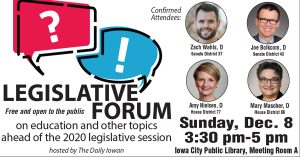UI speech pathologists aim to develop tool to address how aphasia is diagnosed
A new diagnostic model for aphasia created by UI speech pathologists seeks to overcome the fluent/nonfluent dichotomy of the traditional model.
University of Iowa Communications Scientist and Researcher Jean Gordon poses for a portrait in the library of the Obermann Center on November 27, 2019. Gordon is researching ways to more quickly diagnose aphasia. (Ryan Adams/The Daily Iowan)
December 4, 2019
University of Iowa speech pathologists who work with patients that have the neurogenic disorder aphasia — a condition that impairs a person’s ability to understand and express language — aim to improve the diagnostic framework for the disorder.
Jean Gordon, UI Communication Scientist and Researcher, said the existing model is not entirely inadequate but supports the idea that aphasia classification is strictly fluent versus nonfluent — despite some overlap in this distinction and the lack of a direct relationship between certain regions of the brain and specific impairments.
“The problem with any [aphasia] diagnosis that we have to base it on observable behavior. We can’t peek inside the brain to see what the language system is doing,” Gordon said.
Gordon said the traditional model of diagnosing aphasia is not very informative and unreliable, because there are various reasons aphasia patients can be less fluent than their peers.
“[Fluency] is a very superficial behavior. Identifying someone as having fluent or nonfluent speech doesn’t tell us what’s wrong with the language system. It only tells us about how it sounds,” Gordon said. “[The traditional model] is just not very informative and not very reliable, because there are so many reasons [patients] can be less fluent.”
After years of dissatisfaction with the dichotomous diagnostic model, Gordon agreed with a group of her graduate students that there must be a better way to address aphasia.
“What we’re aiming to do is come up with a more detailed and specific way of diagnosing fluency disruptions, which would help identify what is causing them and therefore what therapy should focus on,” Gordon said.
RELATED: Aphasia Reading Club provides safe space for individuals with communication disorders
Gordon began by producing a new model with her then-graduate student Sharice Clough, who is now at Vanderbilt University. Their basic idea was breaking down fluency into main components such as grammar formation, word retrieval, and articulation, Gordon said.
“It’s an ambitious project in that validating any assessment tool is hard work,” Clough said. “There are multiple test phases to establish that clinicians of different experience levels can use the tool and to see if it’s valid in that it concurs with other measures of fluency.”
The new model, which the team calls the Iowa Fluency Test, will look at fluency in a more specific sense. Clough said the test is currently in the preliminary stages of research.
“[The Iowa Fluency Test] gets away from just seeing fluency as this big, multidimensional thing, to narrowing it down to ‘Why is this person experiencing these difficulties?’” Clough said.
This approach to fluency could help clinicians make more specific treatment targets, she added.
“One of the challenges can be where to start [in therapy] and [knowing] where you are going to get the biggest gains for the work you are doing that will result in the best improvements for the patient overall,” said UI communication sciences Clinical Assistant Professor Jocelen Hamilton.
RELATED: Growing in life through stuttering
Hamilton, who Gordon taught during her time as a UI graduate student, said the difficulty of not knowing what types of therapy are best to begin with a patient becomes more pressing when factoring in insurance.
Insurance companies may have limitations on how many times a client can attend therapy, and in-depth evaluations for diagnosis and therapy plans may take several visits themselves, she said.
Hamilton added that the test would improve efficiency, leading to improvements in the effectiveness of the treatments.
“I’m really excited about Dr. Gordon’s work with this, because it will get to the underlying causes beyond who has fluent and nonfluent aphasia,” Hamilton said. “It would be wonderful for helping to diagnose more specifically what the deficits are and help with timeliness.”





















